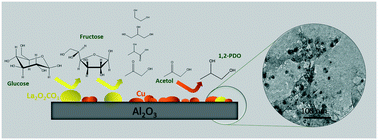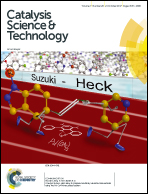Lanthanum oxycarbonate modified Cu/Al2O3 catalysts for selective hydrogenolysis of glucose to propylene glycol: base site requirements†
Abstract
This work reports on the base properties of La2O2CO3–Cu/Al2O3 catalysts and their effect on the catalyst's performance in the aqueous hydrogenolysis of glucose to propylene glycol. The catalysts show promising performance in glucose isomerisation, C–C bond cleavage of fructose and hydrogenation of the resulting fragments. The base properties of the catalyst influence the selectivity. More specifically, the basicity of the catalyst facilitates the isomerisation of glucose to fructose and the C–C bond cleavage of fructose to produce lighter products. This is evidenced by the correlation between the acid–base properties of the catalysts and their catalytic performance. In contrast, acid sites promote side reactions such as condensation reactions. Based on this study, a surface reaction mechanism is proposed for the first step of the tandem reactions, the isomerisation of glucose to fructose. The effect of the reaction time and temperature on the product distribution was investigated to get more insight into the reaction pathways. In this regard, the conversion of intermediates was also investigated. Then, a reaction mechanism was proposed based on the findings of this study and previous works.



 Please wait while we load your content...
Please wait while we load your content...